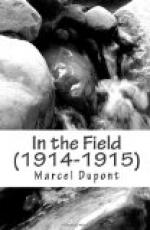The darkness was no longer so dense. The tangle of trees in front of us was less thick, the branches seemed to be opening out, we were near the edge of the wood. And at the same time, in spite of the mad beating of my heart and the buzzing in my ears, I was conscious that the cannonade had ceased, at least in our direction, and that the bullets were no longer coming so thickly. The German attack was probably relaxing; there was to be a respite. So much the better! It would enable us to pass from the wood to the trenches without much danger, thanks to the darkness.
We had arrived! One by one our men slipped into the communication trench. What a sense of well-being and of rest we all had! The little passage in the earth, so uninviting as a rule, seemed to us as desirable as the most sumptuous palace. We drew breath at last. We felt almost safe. But still, there was no time to be lost.
While the Major hurried off to take the Colonel’s orders I climbed up on the parapet. Night had now fallen completely, but the moon was rising. Indeed, it would have been almost as light as day but for a slight mist which was spreading a diaphanous veil before our eyes. In the foreground to the right I could barely guess the dim outline of the battered mill and the burnt farm flanking the trench occupied by the foot Chasseurs. Further off, however, I could vaguely distinguish the row of trees that marked the first line of German trenches, about 250 yards away from us. To the left the mist had a reddish tinge. No doubt yet another house was burning in the unhappy village of Bixschoote.
There was a sudden silence in this little corner of the great battlefield, as if our arrival in the firing line had been a prearranged signal. On our right, too, the intensity of the fire upon the trenches occupied by the —— Territorials diminished. To the left, on the other hand, the gun fire and rifle fire were incessant in the direction of the bridge of Steenstraate, defended by the —— Brigade of mounted Chasseurs. It seemed evident that the Germans, having failed in their attempt to cross the Yser canal near us, were making a fresh effort further to the north. However, it is not safe to rely too absolutely even upon the most logical deductions, for very often the event upsets the most careful calculations and frustrates the wisest plans.
The moon was now shining with extraordinary brilliance, and the fog, far from veiling its lustre, seemed to make it more disconcerting. Persons assumed strange forms and the shapes of things were modified or exaggerated. Our dazzled eyes were mocked by depressing hallucinations; the smallest objects took on alarming proportions, and whenever a slight breeze stirred the foliage of the beetroot field in front of us we imagined we saw a line of snipers advancing.




